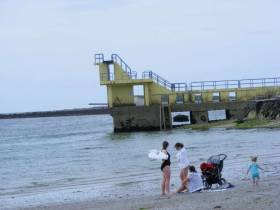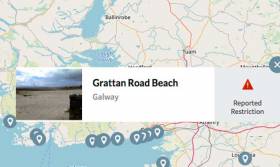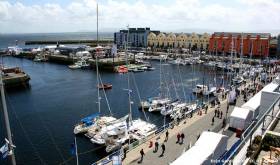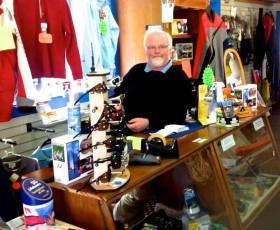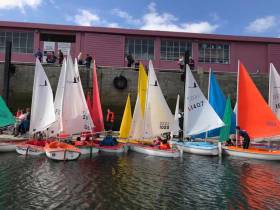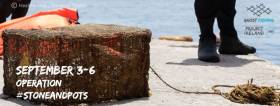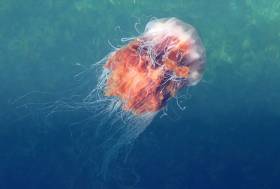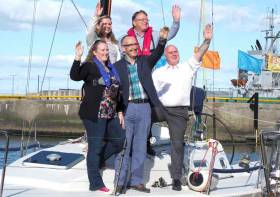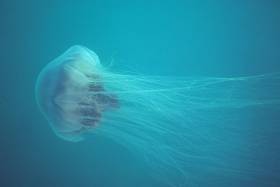Displaying items by tag: Galway Bay
Galway Swim Ban Lifted
A swim ban has been lifted at Galway city’s beaches, following the latest results of bathing water quality tests writes Lorna Siggins
Galway City Council has removed “do not swim” notices at Silver Strand and Salthill beaches on the advice of the Health Service Executive (HSE).
As Afloat previously reported, a ban had been imposed last Wednesday (May 29) on Silver Strand, Salthill and at Blackrock diving board, after very high levels of an intestinal enterococci bacteria were detected during routine testing early last week.
The bacteria may cause illness.
An advisory notice to warn swimmers was also posted at Grattan road beach, where levels were lower.
Galway City Council confirmed on Saturday afternoon that following re-testing of bathing water, results were “positive”.
“The HSE has advised that the prohibition notices on Blackrock and Silverstrand bathing areas may be removed with immediate effect,” it said.
The local authority did not confirm the cause of the pollution. Last week, a spokesman said it was also investigating whether the tests were faulty.
Several sources, such as Mutton island sewage treatment plant and a visiting cruise ship, were ruled out by the city council.
Galway Beach Swim Ban – Update
Galway City Council is investigating whether a testing fault has resulted in high levels of bacteria being reported at several of its beaches.
As Afloat reported earlier today, a swimming ban has been imposed at Silver Strand, Salthill and Blackrock, and an advisory or precautionary notice placed at Grattan beach, after elevated levels of intestinal enterococci bacteria were detected.
The bacteria can cause illness, and bathers have been advised to stay out of the water until there is an “all clear” notice.
Two of the beaches - Salthill and Silverstrand - have “excellent” starring in the Environmental Protection Agency’s new bathing water quality report, while Grattan beach is listed as “sufficient”.
Salthill and Silverstrand, which are within a mile of Galway city, have also been Blue Flag beaches under An Taisce’s monitoring scheme since 2006.
The EPA has now listed a “current swim restriction due to pollution” notice for these beaches on its dedicated website, beach.ie
A Galway City Council spokesman said that no e.coli was detected in the routine testing, and inspection of the beaches found no obvious pollution source or discolouration of water.
“Either an event occurred further out the coast which washed into the inner bay, or the test itself may be faulty,” the spokesman said.
The spokesman that further testing is taking place, but it may be Friday evening or Saturday (June 1) before results are available.
Galway city’s Ballyloughane beach on its east side has reported an improved water quality, after several years of restrictions. It is listed as “sufficient” on the EPA bathing water quality list.
Galway Beach Swim Ban
High levels of bacteria detected in inner Galway Bay have resulted in swimming restrictions being imposed on four Galway city beaches writes Lorna Siggins.
The popular beaches at Silver Strand and Salthill and Blackrock diving board are all affected by a prohibition placed by Galway City Council.
It has also advised against swimming at Grattan beach in lower Salthill.
Very high levels of an intestinal enterococci bacteria were detected during routine testing and the bacteria may cause illness.
Galway City Council says it is investigating the cause, and the prohibition is in place “until further notice”.
It says that further testing is taking place, but it may be Saturday (June 1) before results are available.
Lorient in Brittany was the first city to sign up as a twin to the proud citizens of Galway as far back as 1975. It was a statement of friendship and a commitment to exchange cultural experiences between the people of both historic ports of the Atlantic coast, and it has lasted the test of the last five decades.
Both cities have long and proud maritime histories. They also have very strong cultural ties as they share vibrant Celtic roots, and Celtic culture continues to be very evident in both cites through the everyday use of Gaeilge, Breton, traditional music, dance and the arts.
Co-incidentally, both cities are also the western outposts of their respective countries, surrounded by natural beauty. They have been fishing ports for centuries. They are both aware of the bounties and the threats imposed by the wild Atlantic. This shared life experience made for a good twinning. Obviously sailing - from traditional vessels to modern yachts - is a passion cherished by both.
"The West of Ireland sailing community, from Westport to Kilrush grabbed the idea with both hands"
Sailing fleets from both cities joined forces for a number of very successful events during the ’70s and ’80s, but with other distractions nearer home, the tradition subsequently died away. These sailing adventures started with the northbound departure of a fleet of yachts from Lorient Harbour. After crossing the Celtic Sea and passing by the south-west coast of Ireland, the French fleet arrived into Galway for some serious partying. In Galway, the French boats were joined a Galway fleet to form a formidable flotilla for the southbound journey to Lorient. There, the mother of all parties ensued.
Enda O'Coineen was the catalyst to motivate JeanGab Samzun from Lorient and Cormac Mac Donncha from Galway Bay Sailing Club (GBSC) to join forces last summer in an effort to revive the event in 2019. The West of Ireland sailing community, from Westport to Kilrush grabbed the idea with both hands.
Both City Councils have rowed in behind the idea. Mayor of Galway, Niall McNellis, has been a big supporter. Events have been planned for the Harbour Hotel on the eve of the departure from Galway docks on the 11th July and also at the docks marina on the day of departure, 12th July. For the 2019 event, the French team are again pulling out all the stops for their stage of the event, with plans to fly some Irish dancers in from Galway for the occasion.
 Lorient is the ultimate destination, but there’ll be many stops – including islands – on the way
Lorient is the ultimate destination, but there’ll be many stops – including islands – on the way
The two cities have signed up 33 skippers, mostly from the West of Ireland, to join the craic. There has been great support from neighbouring clubs in Mayo and Clare as well as boats from Lough Derg clubs. The Galway boats to register, from Rosamhil Marina, Galway City Sailing Club, Galway Docks Marina and GBSC, have already reached 17. There is a healthy fleet of 6 joining from Westport on Clew Bay, with four boats from Lorient while another six are joining from Kilrush, Lough Derg and Cork.
A number of well known West of Ireland sailors have signed up for the trip, including Westport’s Jarlath Cunnane of Northabout renown as well, as Dr Michael Brogan from Kinvarra. Michael plans to skipper the renowned extra-large Galway Hooker, MacDuach, to France for a Cruise-in-Company which will cover 1,100 miles in all.
On the Irish coast, the route from Galway towards Lorient will follow the shores of Munster as far as Kinsale, and the committee is very grateful for the warm welcome received from the folks at Kinsale Yacht Club, as well as the Harbour Master in the Isle of Scilly, and of course to the Lorient City Club for organising events on Ile De Groix and in Lorient Harbour.
Galway Bay’s Pierce Purcell Retires From the Marine Business
With a working life in which sailing, business and friendship are so intertwined that it is difficult if not impossible to tell where one begins and another ends, it will be a sweetly sad bit of news for many folk that Pierce Purcell of Galway Bay is officially retiring from active involvement in the marine industry at the end of January writes W M Nixon
Many of his friends will have known that he has been contemplating heading towards new horizons for some years now. Yet it will still feel more than a little strange to be driving through the attractive village of Clarenbridge in the knowledge that it is no longer possible to stop off and drop into the marine Aladdin’s Cave of marine equipment goodies which was Purcell Marine, there to have a yarn with the man himself about everything that was going on in and around boats and the people with them in the western area.
To say that boats and sailing are Pierce Purcell’s life is understating the case. Yet so keen is he to help others get afloat in so many ways that it could be argued that this evangelizing enthusiasm got in the way of his own sailing. So once he has finally handed over the Clarenbridge premises for other use to the new owners, with any spare marine gear and goods and equipment moved to the very fine shed which he has built out the back of his attractive house down towards the famous Moran’s of the Weir, there is a good chance that he will be able to increase the use of his own immaculately-maintained Snapdragon 27 Ocean Spirit.
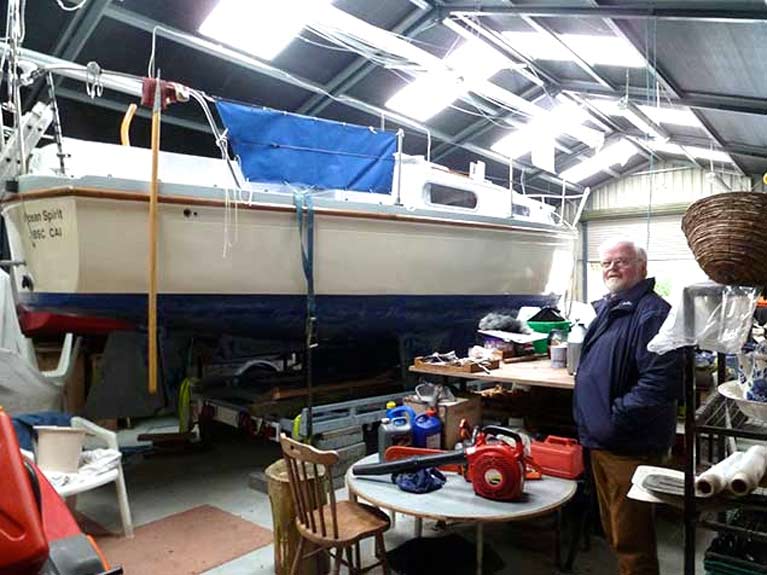 A fresh focal point – the new shed at Clarinbridge, with Ocean Spirit at the heart of it. Photo: W M Nixon
A fresh focal point – the new shed at Clarinbridge, with Ocean Spirit at the heart of it. Photo: W M Nixon
There’s talk of cruising Galway Bay and Connemara in detail, and maybe even a spot of mild adventure inland on Lough Corrib, or across and onto the Shannon at Lough Derg. It’s all within easy reach. Yet with his many commitments and his endless rotas of voluntary work, until now he has been unable to do justice to these sailing paradises which his friends and customers have so readily enjoyed.
But although everybody now thinks of Pierce Purcell and Galway Bay as being synonymous, in fact, he’s from a noted Dublin Bay sailing family, and his father – also Pierce – was Commodore of the National YC from 1945-1948, owning the noted John B Kearney yawl Sonia in partnership with his brother Denis.
However, Pierce Senr’s early death ended those idyllic Dun Laoghaire sailing days with young Pierce aged only eight, and when in 1968 his mother was remarried and they moved west to live in Galway, the only tangible link with family sailing on the east coast was a half model of the Sonia. This was hung on the wall of the teenager’s Galway bedroom, representing recollections of increasingly dimness as he immersed himself in the life of growing into adulthood in Galway.
Boats and sailing were very much part of it, and between 1973 and 1979 he was involved in promoting the Galway Boat & Leisure Shows with fellow enthusiasts like Larry Swan, Barry Martin, Ferdinand Riordan and Brian Siggins. But more importantly in the long run, he had been a founder member of Galway Bay Sailing Club in 1970, where some of his early sailing had appropriately been on the John B Kearney-designed Mermaid class Kirkee May.
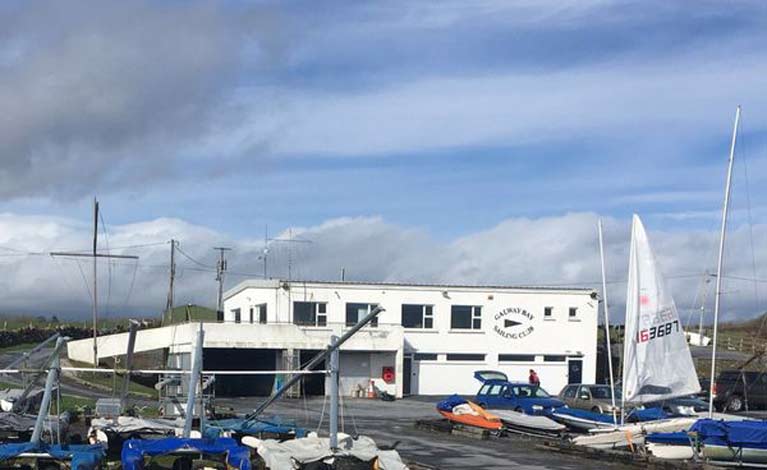 A dream fulfilled – Galway Bay Sailing Club as it is today at Oranmore
A dream fulfilled – Galway Bay Sailing Club as it is today at Oranmore
However, a certain impatience with the speed of development made him realize that an active sailing school was also required, and he set up the Galway Sailing Centre in 1973. Meanwhile his voluntary work with the club continued, such that in 1980-81 – aged just 30 – he was GBSC Commodore. But having done his duty and more with the voluntary effort, he stepped up involvement in the marine business, in 1983 adding a boat sales and chandlery business to new premises in Oranmore.
There, fortune smiled in him, for as it happened he had found those premises in a roadside location which also proved ideal for a filling station to be added in 1989 to service the rapidly increasing Oranmore traffic. Thus he ended up with the unlikely combination of a sailing school with boat and marine store combined with a thriving filling station and cafe, bringing overall business to such a level that in 2001 he was able to sell the entire establishment for a well-earned profit, and move the boat and equipment business as Purcell Marine to the very congenial surroundings of Clarenbridge.
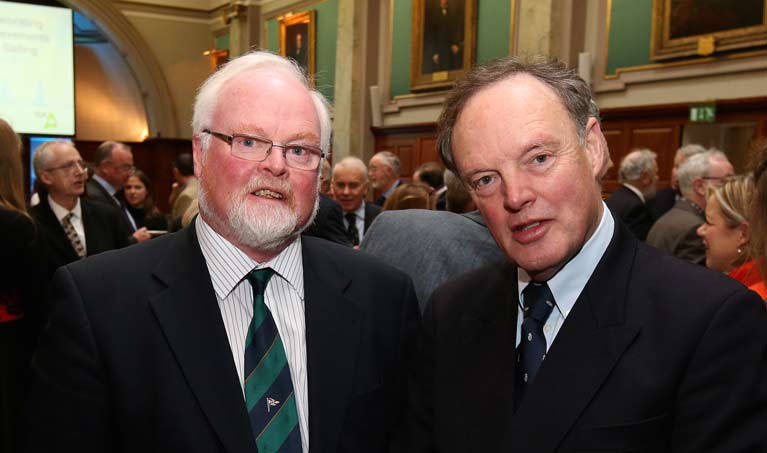 Pierce Purcell (left) Board Member Irish Sailing, and Michael Boyd, Commodore of the Royal Ocean Racing Club, at the Irish Sailing annual National Awards
Pierce Purcell (left) Board Member Irish Sailing, and Michael Boyd, Commodore of the Royal Ocean Racing Club, at the Irish Sailing annual National Awards
It’s a picturesque village strategically located at the head of Galway Bay in such a convenient way that he drew on a clientele from at least the two counties of Clare and Galway, and in reality much further as well. And by this time he was long since settled into married life with Susan and their sons Pierce Jnr and Mark – the former is now in the strength of CH Marine in Cork.
The Purcell family built themselves a dream home on the east side of Clarenbridge, an enchanting house with the big boat and equipment shed out the back, and a sheltered garden where you can see red squirrels at play while enjoying a leisurely breakfast as the morning sun illuminates the scene.
It provides the ideal base for a man who regularly and frequently bursts forth with nautical energy into the wider world, putting in so much voluntary work for sport afloat that he became the Irish Sailing Association’s “Volunteer of the Year” in 2008, and founded the “Galway Afloat” cruising group in 2009 – to date, their biggest success has been a 50 boats-plus rally to Kilronan in the Aran Islands.
That in turn led on to membership of the Cruising Association of Ireland of which he became Vice Commodore, and then in 2012-2016 he served as a Director on the Board of the Irish Sailing Association (now Irish Sailing), where he put in much work with Muriel Rumball of the Irish National Sailing School, developing the Try Sailing initiative.
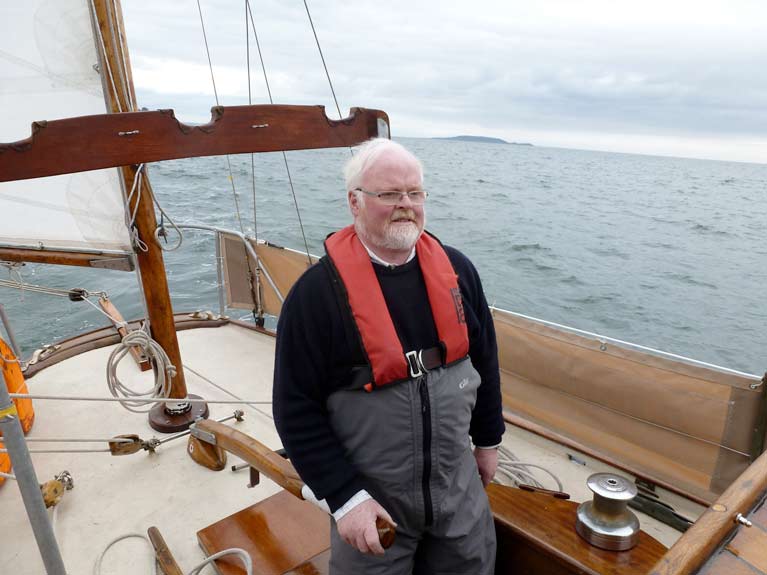 At the helm of the John B Kearney 1912 designed-and-built Ainmara. Photo: W M Nixon
At the helm of the John B Kearney 1912 designed-and-built Ainmara. Photo: W M Nixon
In 2016 old family links were formally renewed when he was elected an Honorary Member of the National Yacht Club, where he had always been a welcome guest, particularly in 2013 when the only John B Kearney cruising yacht still in existence in Ireland, Dickie Gomes’s 1912-built Ainmara from Strangford Lough, ventured southward for some days to the Dublin Bay area, and sailed into Dun Laoghaire with Pierce Purcell on the helm for a reception at the National Yacht Club, where the half model of Sonia played a starring role in a convivial gathering of John B Kearney enthusiasts.
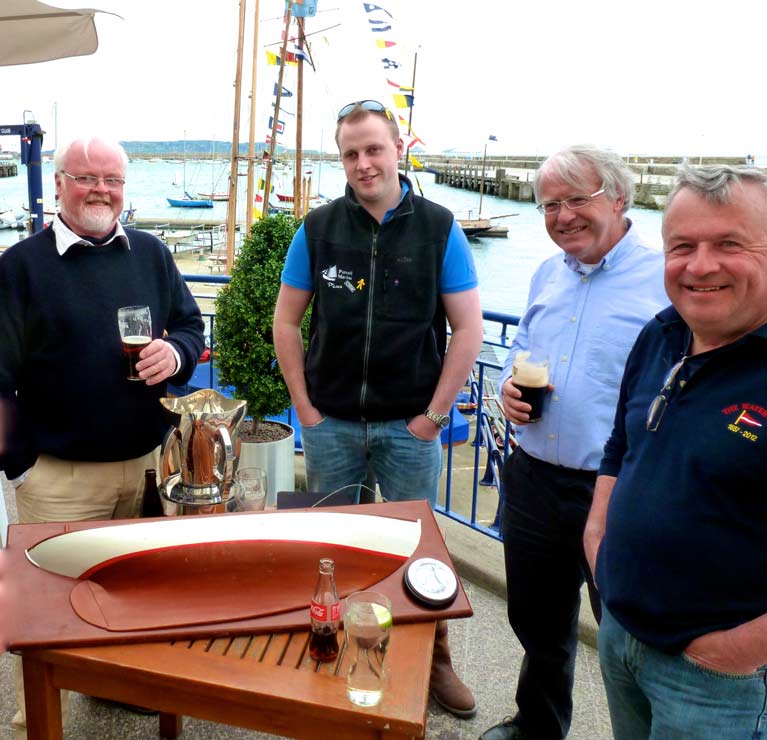 Celebrating John B Kearney and Sonia at the National YC are (left to right) Pierce Purcell, Pierce Purcell Jnr, Ronan Beirne (NYC), National Mermaid Champion Jonathan O’Rourke, and the half model of Sonia (built 1929). Photo: W M Nixon
Celebrating John B Kearney and Sonia at the National YC are (left to right) Pierce Purcell, Pierce Purcell Jnr, Ronan Beirne (NYC), National Mermaid Champion Jonathan O’Rourke, and the half model of Sonia (built 1929). Photo: W M Nixon
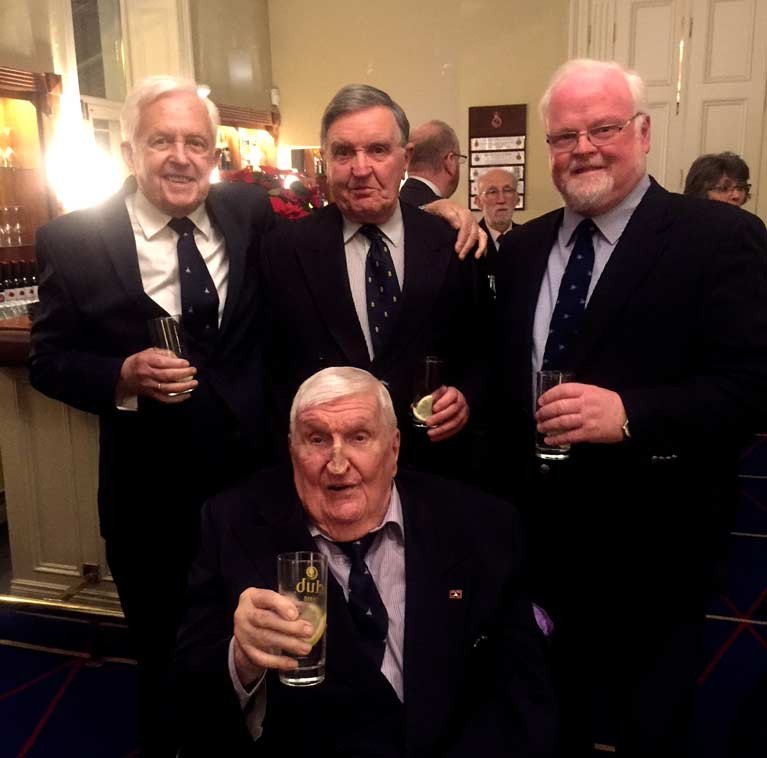 Galway Bay longtime sailing friends celebrate noted skipper Dave FitzGerald’s 90th birthday with (left to right) Tom Foote, Peter Fernie and Pierce Purcell, with Dave FitzGerald foreground
Galway Bay longtime sailing friends celebrate noted skipper Dave FitzGerald’s 90th birthday with (left to right) Tom Foote, Peter Fernie and Pierce Purcell, with Dave FitzGerald foreground
But while he enjoys a party as much as the next man, and has many friends in boats and sailing throughout Ireland, Pierce Purcell is keen that this camaraderie of the sea should be readily and generously available to newcomers.
However, with volunteering being second nature to him, he admits that at times he might expect too much of others in the same way, ruefully acknowledging that in the early days of Galway Bay SC when effort was expected all round, he became known as the “Have You Got a Minute” Man.
Yet nowadays when people are moving away again from the expectation that paid staff are inevitably necessary to run any significant organisation, he finds that club officers can be pleasantly surprised by the positive response they get simply by phoning someone and making a reasonable request for voluntary effort – “We mustn’t see members as customers” is his mantra.
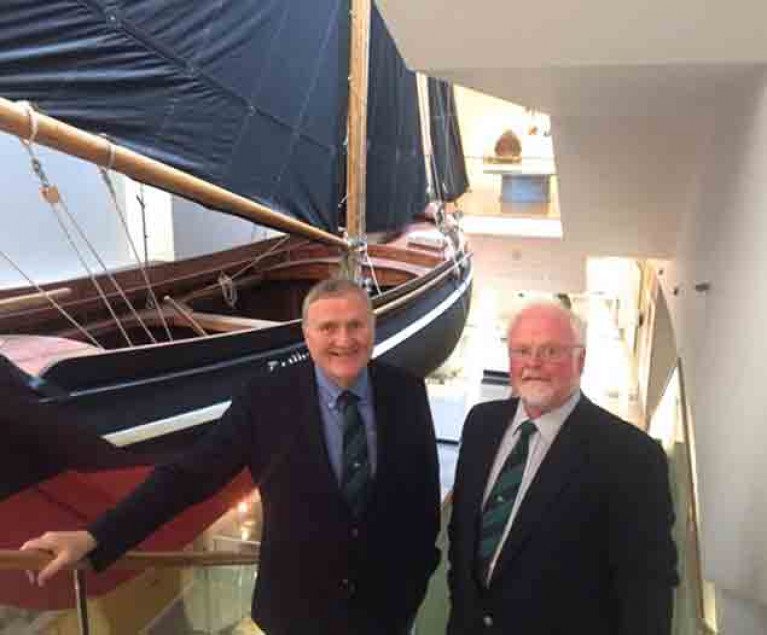 As a noted promoter of western sailing, Pierce Purcell brought Irish Sailing President Jack Roy to the Galway Maritime Museum
As a noted promoter of western sailing, Pierce Purcell brought Irish Sailing President Jack Roy to the Galway Maritime Museum
A new turn in his involvement came in 2017 when he was persuaded to be administrator of Galway Ocean Sports Club in the city’s docklands, and his support for Disabled Sailing has also been an almost lifelong interest. But he admits that the total availability of all forms of modern communication has resulted in a diminution of good old-fashioned get-togethers to sort out problems and get things done – he hugely relishes the mixing of boats and sailing and sociability.
However, after 45 years and more in the boat business, it is definitely time to become more of a consumer himself. Ocean Spirit will soon be ready to go afloat again. The sea and the lakes and the waterways call. And at every port he visits, Pierce Purcell will find he is among friends old and new. We wish him all the very best, the heartfelt thanks of Ireland’s sailing community, and the fairest of fair winds.
Sailability Sailors From all Four Provinces Converge on Galway Galway Bay Sailing Club
This past weekend Galway Bay Sailing Club played host to the Hansa Nationals and Presidents Cup at The Port of Galway. Team of Sailability sailors from all 4 provinces converged on Galway for the weekend and Champagne sailing conditions on Galway Bay on Saturday ensured that enough races where sailed to constitute a championship. Despite the best efforts of the race management teams headed by Dave Vinnell and Aoife Lyons the weather won out on Sunday with no racing being possible.
Twenty-nine boats took to the water with 17 boats on the start line for the Hansa Nationals and 12 boats lining up in the Presidents Cup fleet.
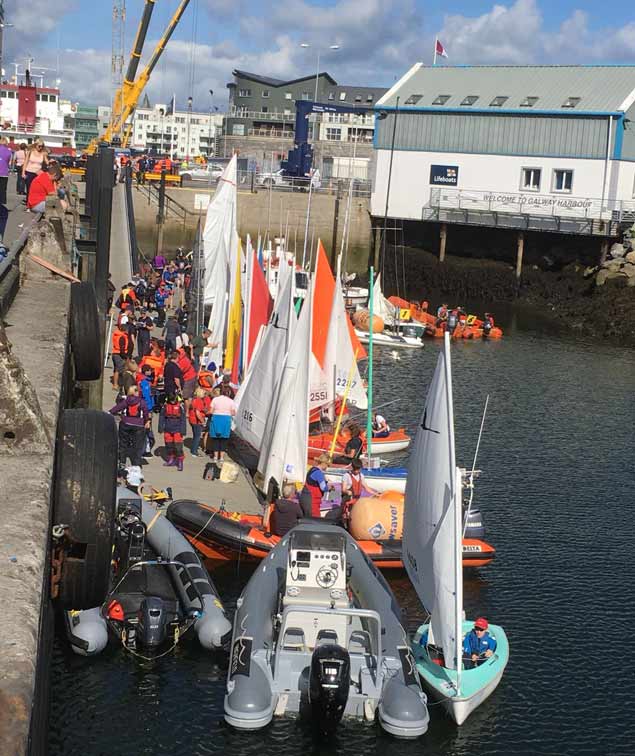
Local crew Jack Cunningham and Gerry Drudy scored two bullets in the last first two races in their Hansa and this coupled with 2 seconds was enough to see them hold off a strong challenge from Judy Moynihan and Maebh Ahearne. This is a fantastic achievement for Cunningham who only took up sailing last year.
Munster came to Galway as favourites to retain the Presidents Cup and so it proved with a string of bullets from Gina Griffin in her 2.mR and Kevin Downing and his crew in their Squib ensuring that the trophy’s trip outside Munster was short.
"A huge volunteer effort from GBSC and indeed all clubs involved went into the event"
A huge volunteer effort from GBSC and indeed all clubs involved went into the event. Liz Gantly, event chairperson, complemented and congratulated all involved in hosting a hugely successful event, singling out Safety Officer Ciaran Oliver and GBSC founding member Pierce Purcell for special mention. It was also noted that the event and indeed all watersports for disabled people in Galway was given a major boost just prior to the event with the installation of a permanent hoist. This was funded by the dormant accounts fund and kindly facilitated by Harbour Master Capt Brian Sheridan.
One final surprise was in store when Sailability stalwart Donal Hickey was presented with the “Spirit of Sailability” award for his long and continued contribution to Sailability Ireland.”
Irish Sailing Adds:
Galway hosted the second Watersports Inclusion Games this weekend (25th and 26th August) for 198 participants with all abilities on the physical, sensory, intellectual and learning
difficulty spectrums. This two-day event aims to show both participants and their families, as well as people who organise watersport events, that everyone can get out onto the water.
The Games had two elements: at the Commercial Boat Club, we put on introductory activities for those new to watersports. This year there was an expanded choice including
sailing, rowing, canoeing, stand-up paddle boarding, and fast-boat rides, with many people trying out all of the watersports activities over the course of the weekend.
The second element was a competitive sailing event. This took place in Galway Bay with more experienced sailors including Kinsale YC’s Gina Griffin, World Sailing 2.4 Parasailing silver medallist competing in the Hansa Nationals, and the President’s Cup which was won by Munster.
Harry Hermon, CEO of Irish Sailing commented: This is the second year of the Games, and we were delighted to welcome all of the participants from the four corners of Ireland. We are
already starting to plan for next year’s Games in Cork, when we hope to reach even more people from all abilities and encourage them to take up watersports”.
Neither event would have happened without the 100 or so incredible volunteers who generously donated their time and expertise.
“It was a pleasure and a privilege to witness the fabulous sailing skills, can-do attitude and camaraderie on display on the water yesterday” Volunteer and mother of participant.
“Just reflecting here on the weekend and I can’t help but smile when I think about it and I will for some time to come….Thank you doesn’t do it justice but THANK YOU!” Parent of
participant
The Games were organised by Irish Sailing, in partnership with Canoeing Ireland, Rowing Ireland, Spinal Injuries Ireland, Galway Bay Sailing Club Sailability, Galway Sports
Partnership, Wet Mongrel Adventures and Waterabilities, and funded by the Sport Ireland Dormant Accounts Sports Inclusion Fund.
Huge thanks also to Galway Kayak Club, St Joseph’s Rowing Club, Tribesmen Rowing Club, Corrib Rowing Club, Gráinne Mhaol Rowing club, Castleconnell Rowing Club, Cork Boat
Club, Castletownbere Rowing Club, Coláiste na Coiribe Rowing Club, Galway Bay Sailing Club, NUIG Sailing Club, Galway Sea Scouts, Bray Sailing Club, Galway Civil Defence and
Galway Sub Aqua Club, Bellacragher Boat Club, Lough Derg Yacht Club, Corrib Yacht and Boating Club, Carna Order of Malta, Dun Laoghaire Sailability, Gartan & Donegal CoCo,
Galway City Council and the many other volunteers and helpers.
The Games were hosted by the Commercial Boat Club, Woodquay and Corrib Navigation Trust with competitive sailing hosted at Galway Docks.
#StoneAndPots - Dutch divers are bringing their campaign against ‘ghost fishing’ to Galway Bay next month, as the Irish Examiner reports.
Previously covered on Afloat.ie earlier this year, the Ghost Fishing Foundation co-ordinates cleanups of lost or abandoned fishing gear that continues to trap marine wildlife on the sea bed.
From Monday 3 September, six technical divers from the foundation will embark on Operation Stone and Pots, removing lobster pots from the bottom of Galway Bay and returning them to local fishermen if they can be reused.
It follows a preliminary dive off the Galway coast this past May that revealed countless numbers of abandoned pots, which continue to pose a threat to sharks and smaller fish as well as crustaceans.
The Irish Examiner has more on the story HERE.
Lion’s Mane Jellyfish In Irish Waters Are Larger Than Usual
#Jellyfish - Lion’s mane jellyfish in Irish waters this summer are much larger than usual.
That’s according to zoologist Dr Tom Doyle, who spoke to The Irish Times after a recent spate of incidents that saw swimmers hospitalised by stings from the dangerous marine species in Galway Bay.
“It is not correct to say this is the first time they have been spotted on the west coast, as we had reports for the last two years, but they are particularly large and mature,” said Dr Doyle.
Lion’s mane jellyfish are more commonly seen in the Irish Sea, and reports of larger specimens similar to those off Galway and Clare have come in from North Wales and Liverpool.
Dr Doyle appealed for the public to report any sightings to the National Biodiversity Data Centre as well as the Facebook page for The Big Jellyfish Hunt.
The Irish Times has more on the story HERE.
Galway Way Bay Sailing Club Launch ICRA & WIORA 2018
This week Galway Bay Sailing Club (GBSC) members and friends gathered at Dock 1 Seafood Bar and restaurant in Galway Harbour for the official launch of the ICRA/WIORA 2018 which will be held in Galway Harbour from August 15th – 18th.
On a gloriously sunny Summer solstice evening the event chairman, Event organiser Martin Breen, kicked off proceedings by confirming how important it is for GBSC to host a national regatta in the Galway Docks.
Martin mentioned that GBSC has had a very sombre beginning to the season with the loss of longtime members Henry Lupton and David Fitzgerald. Even though of different generations, they were like-minded in their promotion of sailing and their exploits have been well documented on ‘Afloat’ie. It was their peers who wrote the constitution of GBSC which includes the club goal of ‘promoting the sport of Sailing on Galway Bay’ and it is within this goal that we sought the hosting of the 2018 ICRA National Championships.
"Please judge us in GBSC on how we contributed to promoting the sport of sailing on Galway Bay"
GBSC are really looking forward to providing the best of Galway hospitality ashore and the best of race management afloat, as the National Championships in any sport deserves.
Even though entries received to date are already in excess of entries to recent National Championships, GBSC says they do not consider this to be a benchmark of the success of the event. "Rather, after the Championships and when we begin to reflect on this season past about the time of the Autumn equinox, please judge us in GBSC on how we contributed to promoting the sport of sailing on Galway Bay".
#Jellyfish - Bathers have been put on alert in Galway Bay after a number of swimmers were hospitalised for stings by lion’s mane jellyfish.
According to the Connacht Tribune, one woman was stung in the face on Saturday 9 June, while two men suffered stings last Tuesday 5 June.
One member of the Galway Triathlon Club spotted a swarm of 10 lion’s mane jellyfish during a recent 4km swim in the bay.
It’s believed to be the first sighting in Galway Bay for almost two decades of the dangerous marine animal, whose hundreds of tentacles can cause potentially lethal anaphylactic shock.
The Connacht Tribune has more on the story HERE.


























